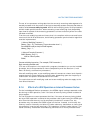
8-14 Vol. 3
MULTIPLE-PROCESSOR MANAGEMENT
has the two loads occurring before the two stores. This would result in each load
returning value 0.
The fact that a load may not be reordered with an earlier store to the same location
is illustrated by the following example:
The Intel-64 memory-ordering model does not allow the load to be reordered with
the earlier store because the accesses are to the same location. Therefore, r1
== 1
must hold.
8.2.3.5 Intra-Processor Forwarding Is Allowed
The memory-ordering model allows concurrent stores by two processors to be seen
in different orders by those two processors; specifically, each processor may perceive
its own store occurring before that of the other. This is illustrated by the following
example:
The memory-ordering model imposes no constraints on the order in which the two
stores appear to execute by the two processors. This fact allows processor 0 to see
its store before seeing processor 1's, while processor 1 sees its store before seeing
processor 0's. (Each processor is self consistent.) This allows r2
== 0 and r4 == 0.
In practice, the reordering in this example can arise as a result of store-buffer
forwarding. While a store is temporarily held in a processor's store buffer, it can
satisfy the processor's own loads but is not visible to (and cannot satisfy) loads by
other processors.
Example 8-4. Loads Are not Reordered with Older Stores to the Same Location
Processor 0
mov [ _x], 1
mov r1, [ _x]
Initially x == 0
r1 == 0 is not allowed
Example 8-5. Intra-Processor Forwarding is Allowed
Processor 0 Processor 1
mov [ _x], 1 mov [ _y], 1
mov r1, [ _x] mov r3, [ _y]
mov r2, [ _y] mov r4, [ _x]
Initially x == y == 0
r2 == 0 and r4 == 0 is allowed


















